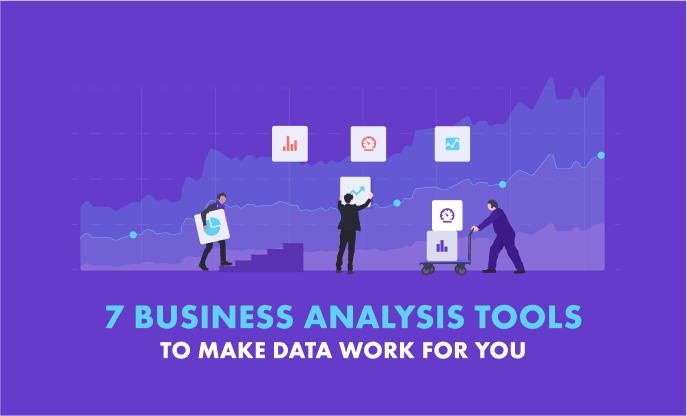You’ve certainly heard of business analysts (BAs) but may not be entirely sure what that role entails exactly. Well, the reason for that lies in the fact that the job differs from organization to organization and can cover a wide range of duties.
But in essence, a BA helps to improve a business, product or service through data analysis. Business analysts are the driving force behind changes in an enterprise – they use data to identify needs and recommend solutions.
A BA needs to know how to work with data, how to use it to identify current and predict future trends, and also how to explain those findings to non-technical members of an organization (usually executives or stakeholders). As such, these versatile workers are the bridge between the IT and the business domains.
Some are more IT inclined, so they are more heavily involved in matters such as software development. Others lean toward the business side of the equation and handle tasks such as project management. But in general, they use data to identify business problems and propose solutions to improve efficiency.
Type of Business Analysis Tools
Because they have such a prominent and far-reaching role in identifying business trends and proposing the appropriate business strategy to address them, BAs cannot do their job without the right business analytics tools.
For one, there is usually too much data to analyze manually. Secondly, the data is often unstructured and raw, needing to be processed before analysis. And finally, once BAs identify the business requirements that need to be addressed, they need to translate their findings into formats which are easy to understand and promote effective collaboration. For all these reasons and quite a few other, certain software tools are integral to the business analysis process.
While it is true that some of these tools share certain functionalities, each one is best suited to specific tasks. And as mentioned, these tasks can be quite diverse. That is why it is possible to divide business analysis tools into three large categories:
Tools Related to Requirements
The work of a business analyst has many requirements, and it can become complicated to manage them all when dealing with large quantities of data. These tools help with that and allow the data analysis to stay on track. Collecting data from the appropriate sources and filtering those often huge amounts of information according to various criteria, all the while keeping different requirements in check – these tools make that possible.
Tools for Modeling
Once a BA has some findings, they need a tool to present them in a way that is simple to understand. Not every member of an organization will have the same analytical skills as the BA, and they need a go-between to see the results. These tools offer diagrams and contextualized representations of data to promote better understanding and decrease the odds of misinterpretation.
Tools for Collaboration
As mentioned, business analysts are the link between different departments of an organization. This means they need effective ways to cooperate. In addition, BAs need to propose fresh ideas based on data and techniques such as brainstorming depend on collaboration.
There are many tools out there, and they can all support different aspects of a BA’s assignment. Still, the point is clear – business analysts need the right tool for the job at hand. And the following seven analytical tools can help make that job a lot easier.
7 best business analysis tools
1. MindMup
MindMup is a brainstorming tool, giving it a wide range of applications. From setting up requirements to collaboration, anyone can benefit from mind maps. Best used at the beginning of a process to bring together the ideas of numerous people.
For example, there are many well-known business analysis techniques that BAs often employ – one of them being PESTLE analysis (Political Economic Social Technological Legal Environmental). Used to assess the influence of the environment on a project, this method can benefit greatly from brainstorming – you want as many potential effects as possible. Of course, there are many other uses for mind maps.
The benefits of MindMup are that it is easy to use, easy to share, and doesn’t require any installation. The downsides are that the notes have a limited capacity, you can’t use it for traditional note storage, and it is a relatively simply program.
When using it, remember you have keyboard shortcuts to speed up the work.
2. Vertica
To get any project off the ground, a business analysts needs to collect large quantities of background information to determine any circumstances which could potentially affect the assignment. This is integral to requirements analysis and stakeholder identification, two essential processes.
As a data discovery tool, Vertica can help with the analysis of big data. It is fast, reliable, and boasts some advanced analytical functions. On the other hand, there are some limitations with data size, certain issues with queries under specific circumstances, and the price can get up there.
Still, its analytics capabilities set it apart, and you would do well to utilize its cloud integration potential.
3. SAS
When it comes to data manipulation tools, SAS is one of the dominant forces on the market. It can mine data from numerous sources, manage and alter it as needed, then carry out a statistical analysis. As such, it is integral in defining project requirements.
SAS is feature-rich, offers great analytics potential and comes with great support. A strong feature is the sheer number of secondary tools that enhance and support it. As for the disadvantages, it doesn’t get updates as quickly as some of its competitors, it can also be more expensive, and its visualization options could be better (although they are by no means bad). A good tip is to get SAS certification – this can help you as a business analyst.
4. LucidChart
As a diagramming tool that supports real-time collaboration, LucidChart merges the modeling and collaborative categories of analysis tools. As such, it is great for establishing business objectives. It particularly stands out when there are lots of rapid changes to the diagram in question.
For example, it can make SWOT analysis (Strengths Weaknesses Opportunities Threats) reports much easier to create by allowing multiple BAs to work on them simultaneously.
It is easy to learn, responsive and has well-stocked object libraries. Although its template options aren’t the greatest, there is no desktop version of the program and it costs a bit more than some other diagramming solutions.
5. MindMeister
Another mind mapping tool, making it useful for tasks such as brainstorming, planning, or defining the scope of a project. Again, it can see a broad application in business analysis, mainly because it supports real-time collaboration. Also, it is also rather intuitive and simple to use. On the other hand, some of its functions are rather basic (such as link types), the free version only allows three mind maps and there are more affordable options out there.
But as a bonus, it has a mobile version – meaning you can use it on the go.
6. KissMetrics
KissMetrics provides a very efficient way to obtain behavioral data from website visitors. Therefore, it is the foundation for the subsequent work of business analysts, allowing them to get the information they need to come up with solutions and new strategies.
It allows you to generate custom reports, to receive daily snapshots that show you the most important metrics, and is great for funnel reports. On the flipside, its learning curve can be a bit steep if you’re not tech-savvy, reporting can be limited in some cases and the price can be an issue for some users.
For full benefits, make use of its automation options.
7. Tableau
When you need a visualization tool for business analytics, Tableau is what many refer to as the gold standard. As such, it is a stalwart of the modeling category of tools.
Tableau is powerful, produces very professional-looking results, and can handle multiple sources of data. The disadvantages are that it can be pricey, you might have certain problems embedding it, and some of its functions take time to master.
If you do opt for it, make sure to take advantage of the fact that the company is excellent at supporting its community. There are events, forums, and user groups you can benefit from.
Final Thoughts on Business Analysis Tools
The same way so many professions out there depend on the appropriate tools, a business analyst cannot do their job without the right software. From data analysis and modeling to collaboration, you need the proper programs to make it all work.
Since the market has no shortage of available options, there are many criteria to take into account when choosing which analysis tool to go for. Parameters such as ease of use, pricing models, visualization options, integration of multiple data sources, real-time collaboration capabilities, and many more.
Hopefully, this text will help put you on the right track. It is important to carefully analyze your needs and go for a solution that suits them explicitly. But with the right tools, a business analyst can generate much more value and create positive changes.






Have a look at our social media